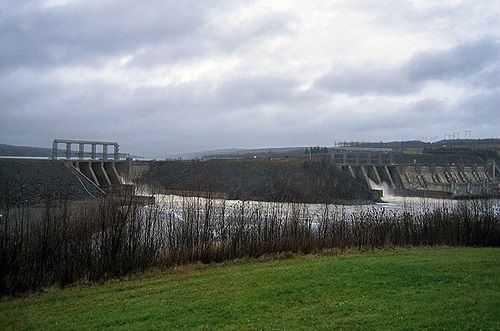Impacts of a Chemical Reaction which causes Structural Problems in Concrete Dams
Published on by Water Network Research, Official research team of The Water Network in Academic
When the Mactaquac Dam opened in New Brunswick, Canada, in 1968, it was expected to have a service life of 100 years, but a chemical reaction occurring within the concrete used to build the dam has drastically shortened that timeline.
"Concrete is a mix of cement, crushed rock, sand, and water. Alkali-silica reaction, the cause of the major issues in New Brunswick, occurs when alkalis in the cement pore solution encounter reactive forms of silica in the rock used to make the concrete," explains Jeremy Gregory, executive director of the MIT Concrete Sustainability Hub (CSHub). "The reaction produces a gel which expands as it absorbs water and exerts pressure that can cause cracking and result in structural problems in concrete infrastructure."
Researchers from the CSHub, the University of New Brunswick (UNB) and Oregon State University (OSU) have teamed up on a project to address several concrete durability issues, including alkali-silica reaction (ASR).

Mactaquac Dam
Researchers at UNB are conducting ASR experiments, while OSU researchers are leading work on another durability issue known as freeze-thaw. Most of the project's computational work is done at MIT, along with some experimental measurements.
"Our research collaboration looks at understanding ASR from fundamental building blocks," explains Thomas Petersen, a grad student in the MIT Department of Civil and Environmental Engineering and research assistant with the CSHub. "Starting from an atomistic description, we wish to understand the mechanisms leading to the expansion of the bulk concrete composite. Is the gel expanding? Is the CSH [calcium-silicate-hydrate] expanding? We are looking to answer these questions by understanding the molecular configurations of the materials."
"Seeing the impacts of ASR on a structure that large, in person, makes you realize how big this problem is; not only is this major dam supplying electricity, it's making sure a pretty big city won't be flooded," says CSHub postdoc Laurent Béland.
The Mactaquac Dam has swelled some 9 to 12 inches in height since it was constructed 50 years ago. Cracking is visible throughout the structure, but the issues extend well beyond the concrete.
The civil engineers and cities planners who built the Mactaquac Dam did test the aggregate for susceptibility to the alkali-silica reaction, however they did not test under conditions that well represented the conditions of the dam.
Source: Phys.org
Media
Taxonomy
- Dams
- Building Construction
- Building Materials
- Concrete
- Non Destructive Testing of Dams